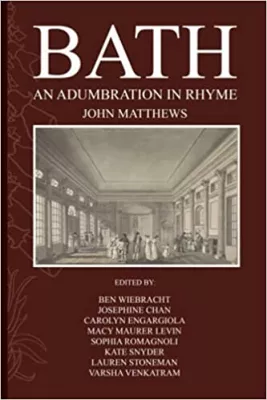Published

Ben Wiebracht, Josephine Chan, Carolyn Engargiola, Macy Maurer Levin, Sophia Romagnoli, Kate Snyder, Lauren Stoneman, and Varsha Venkatram, eds. Bath: An Adumbration in Rhyme. By John Matthews. A Critical Edition for Readers of Jane Austen (Pixelia Publishing, 2021). 41 pp., 10 illus. (Pbk., $9.99; ISBN 978-1737033011). https://pixeliapublishing.org/bath-an-adumbration-in-rhyme/
Is literary scholarship finally ready to embrace undergraduate-supported, collaborative research? What about high school students? COVE, with its opportunities for instructors and students to collaborate on literary texts, has provided one promising model for such work. This edition of John Matthews’s satirical 1795 poem, Bath: An Adumbration in Rhyme, offers another.
Ben Wiebracht has worked with seven students at Stanford Online High School to produce an attractive edition of this little-known poem, which is available as a free download or as an affordable printed volume. The volume includes a biographical essay on Matthews, a contextual essay on Bath and the history of Bath satire, and a thoughtfully annotated edition of the poem. It is the first volume in the publishers’ promised Forgotten Contemporaries of Jane Austen series.
Matthews’s diverting poem is a good choice for such a project. At 168 lines, the poem takes up only six of the publication’s fifty-odd pages. But it provides plenty of topics for discussion. First, the author himself: Matthews (1755–1826) is a little-researched poet and physician, but one with enough standing to merit a brief ODNB entry. Some readers might be more familiar with his son, Henry Matthews (1789–1828), author of The Diary of an Invalid (1820). As a work focused on Bath in the 1790s, the poem serves as a focal point for various historical and literary contexts. Especially helpful are the remarks on the longer history of Bath satire. As the authors show, Matthews owes quite a lot to Christopher Anstey’s 1766 New Bath Guide.
As the edition’s subtitle makes clear, Wiebracht and company are particularly interested in what reading an obscure poem on Bath might tell us about Jane Austen. To this end, the authors have come up with an ingenious, three-column design. The poem appears on the left-hand page, while each facing page includes one column for annotations and a second for Austen-related commentary. Illustrations from Thomas Rowlandson and others provide humorous and helpful images of Bath settings and personages. The images are rather small in the printed version, though online viewers can easily enlarge them.
I was impressed with the care that went into this production. Having read it through several times, I only spotted one, very minor typographical error. I wrote to Ben Wiebracht about this, and it no longer appears in the online version. One might argue that creating a print edition is overkill; but is there anything better in scholarship than receiving one’s own book for the first time and sharing it with others? The authors of Bath: An Adumbration in Rhyme get the best of both worlds: an online edition that can be accessed across the globe and corrected if any serious errors are discovered, but also a paper copy to hold in their hands.
As a scholar of Romanticism, I thoroughly enjoyed spending a few hours being introduced to an unfamiliar author and work from the era. While the authors’ own interests are in drawing connections between Matthews and Austen, it made me wonder if Lord Byron—a friend of Matthews’s son Charles Skynner Matthews (1785–1811)—read Matthews’s satires. Other readers will no doubt make other connections.
Pixelia’s commendable goal is to produce editions accessible to a wide readership. Still, I’m not fully convinced by some of the editorial choices. While few would argue with replacing a long ‘s’ with a short ‘s’, the decisions to remove all italics from Matthews’s poem and to modernize spelling are more debatable. This is especially the case since Matthews’s poem is extremely rare and does not currently appear on any free online sites (it is apparently available on some versions of ECCO). While I appreciate the editors’ decision to create a reader-friendly edition of Bath, it would surely be interesting to compare the original poem to this version, which might bring up classroom questions about shifting orthography. I hope Wiebracht will consider adding images of Matthews’s original pamphlet to the online version.
I tip my scholarly cap to any instructor willing to take on an ambitious project like this. In 2013, my colleague Shef Rogers and I worked with fourth-year Honours students at the University of Otago to transcribe, annotate, and introduce a collection of previously unpublished letters of Romantic-era women writers. It was both one of the hardest and most rewarding experiences of my academic career. At the end of the university year, I was dazed and exhausted. I’m still not sure if I would ever take on such a task again. But our students had produced a work of real and ongoing scholarly value.
The same could be said for this edition of Bath: An Adumbration in Rhyme. Varsha Venkatram, Lauren Stoneman, Kate Snyder, Sophia Romagnoli, Macy Maurer Levin, Carolyn Engargiola, Josephine Chan, and Ben Wiebracht deserve our thanks and praise for their achievement. I look forward to future collaborative productions from Pixelia Publishing.
